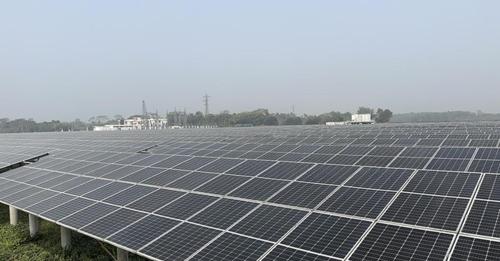
China takes the lead in driving Asia’s energy transformation.
The Sirajganj photovoltaic (PV) power station, the largest solar power project under construction in Bangladesh, has been connected to the power grid, Power Construction Corp of China said on Saturday.
It is an important step for Bangladesh in the development of renewable energy and also underscores the positive role China can play in advancing the optimization of the regional energy mix and industrialization.
Bangladesh has long grappled with energy shortages, and its energy mix is largely dependent on imported fuels such as oil and gas. This dependence leaves the national economy vulnerable to fluctuations in global energy prices, increasing economic risks. Also, uncertainties in energy supply have limited the sustained development of Bangladesh’s industries and economic diversification efforts.
In this context, the construction of PV power plants and other green energy capacity is undoubtedly of great significance to Bangladesh’s energy transformation and industrialization.
The improvement of infrastructure, particularly ensuring a reliable electricity supply, is crucial for Bangladesh to deepen its integration into the global industrial chain. A stable electricity supply is fundamental for industrialization and modernization, and plays a pivotal role in attracting foreign investment and fostering industrial development.
As a key global player in renewable energy technology, China has achieved large-scale application of renewable energy in the domestic market, accumulating rich experience in technical research and development, equipment manufacturing and project implementation areas. China’s solar and wind power capacity has been the largest in the world in recent years, and Chinese companies have built a large number of renewable energy projects around the world.
It is under these circumstances that China and Bangladesh have conducted extensive cooperation in the renewable energy field under the Belt and Road Initiative (BRI).
According to incomplete statistics, since Bangladesh joined the BRI, China has constructed 27 power projects, including PV power, hydropower and wind power projects in Bangladesh. The capacity of power stations built with the participation of Chinese companies in Bangladesh exceeds 9,038 megawatts, accounting for about 35 percent of the country’s total installed capacity and providing a stable power supply guarantee for the rapid economic and social development of Bangladesh, according to media reports.
Indeed, Bangladesh is not the only economy in Asia that is pursuing renewable energy. With the accelerated development of industrialization in Asia, especially in South Asia, rapid economic development has led to a sharp increase in energy demand.
However, the supply of traditional energy sources often faces limitations from resource constraints, environmental protection requirements and price fluctuations in international markets. The discrepancy between supply and demand exacerbates the issue of energy shortages, posing a significant challenge to regional economic development.
Therefore, the development of renewable energy is a crucial and urgent issue in the region, as it offers the solution to address energy shortages and facilitate the energy transformation.
South Asia, in particular, with its unique geographical location and climate conditions, is abundant in renewable energy resources, providing the region with a natural advantage in renewable energy development.
Chinese companies are undertaking renewable energy projects in Asia, including hydropower, wind power and solar power. These projects have increased local power supply capacity and led to the development of related industries, creating jobs and improving local living standards.
Furthermore, China’s collaboration with other Asian nations in the realm of renewable energy has significantly advanced regional cooperation. Leveraging its technological prowess, China has lowered the costs of renewable energy while enhancing its effectiveness and dependability. These technological breakthroughs have been shared with other Asian countries through international partnerships, facilitating their transition toward sustainable energy and fostering the growth of industrial networks and regional economic integration.
Source: Global Times, Aug 04, 2024.
https://www.globaltimes.cn/page/202408/1317350.shtml.